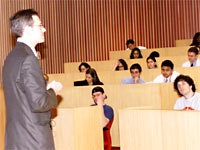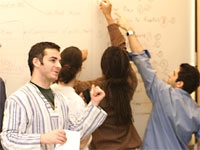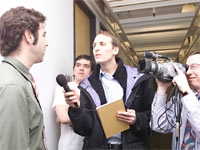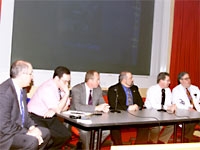
Dr. Nathaniel Hupert introduces the case and assignments to the Class of 2006.
The Medical College staged an innovative bioterrorism exercise on March 25 in Weill Auditorium for the Class of 2006. The session, led by Weill Cornell faculty and a number of NYC-based emergency response experts, was the nation's first medical student class-wide exercise designed to introduce medical students both to the biological pathogens that could be used in a bioterrorist attack and to the command and control systems used by public health officials to manage the physical and psychological effects of such an event.
The purpose of the exercise, which involved a hypothetical outbreak of plague in New York City, was to provide students with a "ground-eye view" of how health-care systems can organize to respond to bioterrorism and other public health emergencies. In contrast to more traditional bioterrorism curricula that stress the recognition and treatment of rare conditions (like plague and anthrax), the organizers of this session wanted students to come away from the day with an understanding of how public health, emergency management and medical professionals need to work together to "solve" the crisis. The authors and organizers of the case, titled "Command vs. Chaos," were Dr. Nathaniel Hupert, assistant professor of public health and medicine; Dr. Peter Marzuk; associate dean for curricular affairs; Dr. Carol Storey-Johnson, senior associate dean for education; Dr. Kent Sepkowitz, associate professor of medicine; and Shailen Sehgal, '06.

Students from Weill Cornell's Class of 2006 at work building an Incident Command System (from left): Michael Gelfand; Daniel Langsam; Flora Waples-Trefil; Marcus McFerren; and Joseph Habboushe.
In the days preceding the March 25 session, students received preliminary information about the fictional disease outbreak. Before the exercise day, they were asked to complete assigned readings and attempt both to identify the "unknown" disease-causing agent and to describe steps that could be taken to treat and minimize the psychological impact of a large-scale bioterrorist attack. Additionally, students were asked to outline an Incident Command structure to respond to the emergency based on their readings of the new National Incident Management System, published by the Department of Homeland Security in March 2004.
Following an introduction by Dr. Hupert, students headed to one of the five one-hour strategy sessions, where they were randomly assigned a role to play during the exercise, such as "Mayor of New York," "Director of the U.S. Centers for Disease Control," or "Chief Medical Officer, NewYork-Presbyterian Hospital." Then, using Internet-based resources, the readings, and their individual views about how best to stop the epidemic, students collaboratively established their Incident Command structure (this time populated by real students playing their assigned roles) and developed a prioritized "action list" of things to do to save the city. Heated debates ensued over everything from the jurisdiction of assigned roles to the most important steps needed to prevent new cases of disease and effectively treat victims.

Weill Cornell medical student Samuel Gerson, playing the role of his team's "Public Information Officer," is interviewed by Sean Kelliher and Peter Buchta, while Gabriel Pitta, '06, looks on.
Unbeknownst to the students, the facilitators assisting in these five groups were actually some of the key public officials in New York City charged with preparing for and responding to such a bioterrorism event, including officials from the NYC Office of Emergency Management and the Department of Health and Mental Hygiene. To add a touch of realism, Sean Kelliher, a media associate in the Department of Public Affairs, made a guest appearance to each of the five sessions, acting as a news reporter with urgent questions regarding the unfolding bioterrorist crisis. To top it off, the five students who were chosen by their teams to be interviewed stepped out into the hall and into the bright lights of a live video camera, operated by Peter Buchta of the Department of Audio Visual Services, who pretended to be the news channel's cameraman.

From left: Eliot Lazar; Sam Benson; Jack Delaney; Edward Gabriel; Scott Phelps; and Dr. Joseph Fins.
At the close of the hour, students reconvened in Weill Auditorium to hear spokespeople from each of the five groups describe their command structure and their priority lists. As a surprise, the video clip of each of the five newly minted "Public Information Officers" was played as well, to universal applause. During this time, each group received feedback from the expert facilitators, whose identities were finally revealed. They included Edward Gabriel, E.M.T.-P., M.B.A., deputy commissioner for Preparedness of the New York City Office of Emergency Management (OEM) and lecturer in public health at the Medical College; Samuel Benson, E.M.T.-P., director of Health and Medical Affairs at NYC OEM; Scott Phelps, J.D., M.P.H., assistant commissioner of the New York City Department of Health and Mental Hygiene and director of that agency's Bureau of Emergency Management; Eliot Lazar, M.D., vice president for Medical Affairs of the NewYork-Presbyterian Healthcare System; and Jack Delaney, director of Emergency Medical Services at NYPH. Additionally, students heard commentary on the ethics of triage from Dr. Joseph Fins, professor of medicine and public health at Weill Cornell.
In the end, students of the Class of '06 accomplished the ambitious tasks of establishing an Incident Command System (ICS) model that organized all roles into a coherent team with lines of authority and responsibility; determined critical priorities for protecting the public's health; developed a rationale for their choices; and—through the efforts of designated team members—communicated their findings to the entire class. As noted by Dr. Alvin Mushlin, chairman of the Department of Public Health and the Nanette Laitman Distinguished Professor of Public Health, "This was a great example of active learning."
Photos by Weill Cornell Art & Photo.

